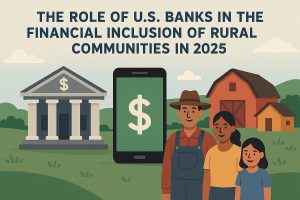Banking regulation in the United States is what underpins the public’s confidence in the country’s financial system. As much as it may seem distant from the daily lives of Americans, it directly affects consumers because it influences banking institutions, their products, and services. So, if you have an account, whether checking or savings, a credit card, or investments, you have certainly been influenced at some point, even if you haven’t realized it.
Therefore, for Americans, understanding these regulations goes far beyond mere curiosity—it’s a strategy. After all, knowing how rules shape fees, credit limits, or fraud protections will allow you to make more informed decisions. With this in mind, let’s explain how these rules impact you, in a practical and real way.
What is banking regulation and why does it exist?

Banking regulation is the set of rules imposed by government agencies. Its main goal is to ensure that the financial system remains stable. But who oversees this regulation? In the US, agencies such as the Federal Reserve (Fed), the Office of the Comptroller of the Currency (OCC), and the Federal Deposit Insurance Corporation (FDIC) play central roles in this process. In this case, they supervise everything from the creation of new banks to how credit is granted to consumers.
These measures are here to protect both the economic system and your money. A great example we can use is the 2008 crisis, where the absence of more effective regulation led to financial collapses that affected the entire population. For this reason, new rules were implemented to prevent abuses, thereby reinforcing transparency and reducing risks in banks.
Key areas of life affected by regulations
US banking regulations directly affect various aspects of Americans’ lives, as we can see. But it’s not limited to just the internal workings of institutions; it also affects how consumers access credit, deal with interest rates, and receive support against fraud. Therefore, understanding how it impacts our lives is essential to making safe decisions.
Among the most affected points, we can start with the use of credit cards, where standards like the CARD Act regulate fee increases, in addition to establishing limits for penalties and clarity in information.
Another point we can mention is interest rates, which, although defined according to the customer’s profile, follow fair and transparent criteria, avoiding undue increases. Furthermore, banking fees on withdrawals, account maintenance, and transfers are also monitored.
Comparison: Direct effects of banking regulation on your daily life
| Aspect | Before Current Regulations | After Implementation of Regulations |
|---|---|---|
| Credit card interest rate increases | Could occur without prior notice | Requires 45-day advance notice under the CARD Act of 2009 |
| Unexpected charges | Common and not very transparent | Greater transparency and limitations imposed by the Truth in Savings Act |
| Fraud protection | Customer was often held responsible | Reimbursement guaranteed if reported promptly, under Regulation E |
| Bank stability | Uncertainty during financial crises | Deposits insured up to $250,000 per account by the FDIC |
| Access to credit | Inconsistent and discriminatory criteria | Fairer and more transparent rules under CFPB supervision |
This comparison shows how regulatory changes are not merely formal, but directly reflect in your experience as a customer. Each measure seeks to balance the interests of banks with the rights of users, promoting a fairer and more efficient system.
Rules that affect your credit card and your limit
Banking regulation influences one of the most sensitive points for consumers: credit cards. It directly affects the operation of issuers and the criteria used to release or restrict limits. The CARD Act of 2009 was created with the intention of preventing abuses against consumers, such as sudden increases in interest rates or changes in the contract.
Therefore, financial institutions now need to inform customers in advance when making any changes, whether to the fee or limit. This can mean fewer surprises for the customer at the end of the month. In addition, the rules influence how banks evaluate your profile, establishing minimum criteria to ensure more fairness and less discrimination in access to credit.
Banking fees: What can be charged?
The charging of banking fees is another area affected by banking regulations. There is a series of rules that banks must follow regarding what they can and cannot charge customers, especially on checking accounts, credit cards, and ATM withdrawals. The Truth in Savings Act, for example, requires full transparency about the fees that will be applied at the time of account opening.
Consumer safety and protection
One of the main points of regulation is to ensure that your money is safe in institutions, especially against fraud and bank failures. The FDIC, for example, insures up to $250,000 per account, so customers are protected if the institution happens to fail.
In more serious cases, such as fraud, Regulation E ensures that customers are reimbursed if the improper transaction is reported in a timely manner. This provides extra protection for online purchases and electronic transfers. Therefore, it’s essential to be aware of the regulations that help you.
What to expect from the future of US banking regulation
With the advancement of cryptocurrencies, artificial intelligence, and digital financial platforms, new banking regulations are being discussed with each change in the financial sector. The expectation is that supervision will become much more complex and adaptable, but of course, without losing consumer protection.
As for the customer, this may mean that the relationship between consumer and bank will continue to evolve, with more transparency, technology, and much more security. Therefore, stay alert to legislative changes to understand your rights and ensure smart and informed choices.
Conclusion
For some, concluding that US banking regulation directly affects consumers in their daily lives may seem like an exaggeration, but we’ve shown that with knowledge, we can see that it’s not quite like that. From cards to personal information passed to the bank, everything is shaped by rules that aim to protect the consumer. Therefore, understanding these rules is not just to avoid pitfalls but to be able to take advantage of the products offered by institutions.
If you want to keep up with the main changes in the financial sector, understand how they impact your financial life, and make smarter decisions that save you money, don’t miss the information on Agora na Mídia. Here you’ll find relevant, up-to-date, and accessible content about what really matters to your wallet.






